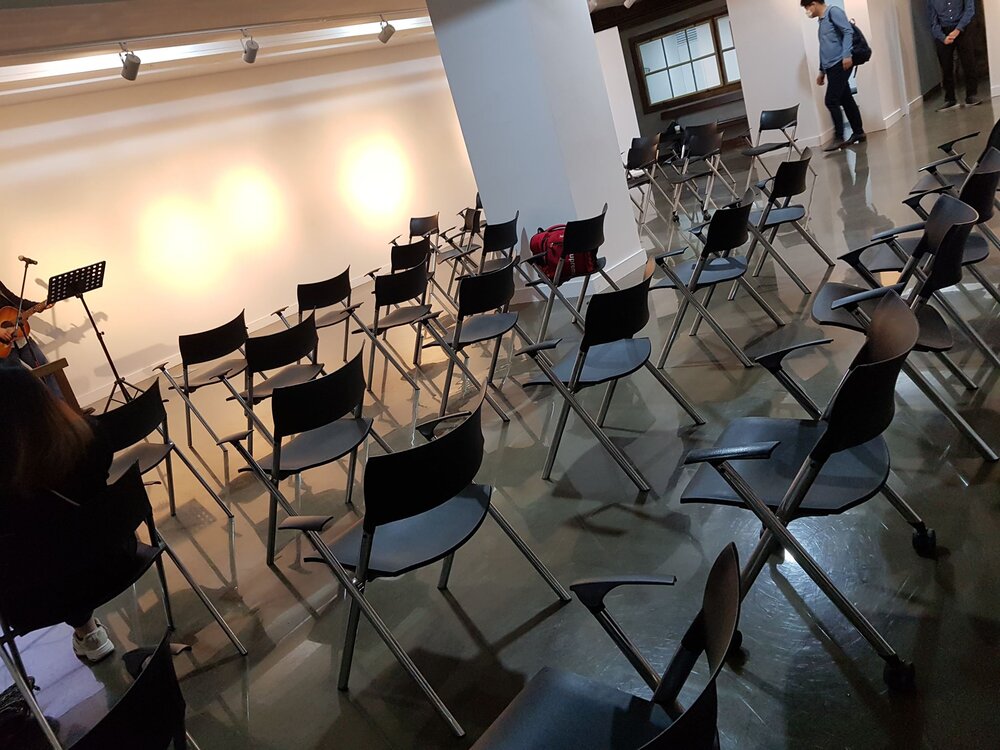Beginning in early May, government restrictions in Korea began to ease, and churches slowly began opening back up. Most communities, including my own church, opted for a hybrid service, providing physical gatherings as well as an online livestream alternative.
Those coming had to take precautions like pre-registering to attend service, having temperature checks, sanitizing hands at the door, and signing waivers that they have not shown flu-like symptoms nor have been in contact with those showing symptoms.

Our worship style changed to a more simplified worship team, shorter messages, and no passing of offering baskets, sharing snacks or even taking communion. Even greeting time became a friendly nod to “one another.” When my people complained that they have to wear masks to church, I tell them, “Even before Corona, you were wearing one each week anyways!”
But just as we thought it was all over and time to return to the normality of life, COVID cases broke out again as terms like Itaewon clubs, Coupang clusters, mandatory 14-day quarantine, and non-renewable visas for foreigners became the common talk of the day. So the return to normal has not happened yet.
COVID-19 Effects on the Church in Korea
Parishioners in Korean churches have been struggling because of the isolation. After all, the idea of not “meeting together” in community is so contrary to the church’s core values (Hebrews 10:25). The phrase “one another” is used over 60 times in the New Testament — love, greet, serve, and even put up with “one another.” After God saw all that was good in creation in Genesis 1, in Genesis 2, He saw it was not good that man should be alone.
One young lady in my church wrote to me, “Pastor Leo, I have been very depressed these days. Sometimes I even wonder if God is there. Is this normal? Why do I have to question God? I’m so tired of doing everything myself now…I feel like I have no control of my situation anymore.”
So we too struggle with the question: How does one practice “one another” when physical meetings are not possible?
Further, the Korean church was forced to wrestle with its own identity. What is worship when there is no building to come to? What is a Christian when one cannot worship at a place? Can we call it worship when there is no band or stage?
In a previous article, I wrote about COVID’s unmasking of our society’s idols, as well as that of the church in South Korea. We’ve all been exposed, not necessarily to the virus, but by the virus. The gods of “success at whatever cost” and “education at the sacrifice of our youth” do not really matter when death stares you directly in the face. Even churches can easily fall into the traps of overvaluing higher attendance numbers, building projects, and expansive budgets, all in the name of expanding God’s Kingdom.
Just like the coveted things hidden under Achan’s tent (Joshua 7), our idols are easily cloaked behind the veils of religiosity, and Jesus often overturns the temple tables of our hearts to reveal what lies beneath.
Jared C. Wilson wrote, “In times like this, what we believe about church rises to the surface…Churches trying to define their brand as cool, counter-cultural, or young is nothing new. But this emergency has brought some of the worst examples of the religious consumerism in evangelicalism to the forefront…”
In other words, generally speaking, we saw one of two things happen — our church people used their time of semi-quarantine to really draw deeper into God and cultivate themselves for the next season, or they became more passive and drew further apart. After all, the identity of many Christians in Korea is built on going to church once a week.
Brett McCracken hit the nail on the head in, “Coronavirus Could Kill Consumer Christianity.”
“For Sunday-only or Sunday-mostly Christians, whose faith is largely defined by a few hours on Sunday mornings, COVID-19 is a game-changer. In a season when the Sunday experience has become drastically reduced to essentially a YouTube video or Zoom meeting (an absolutely temporary and less-than-ideal compromise), Christians are forced to consider what faith looks like when “going to church” isn’t part of it. This crisis is a great opportunity for believers to think afresh about what it means to be distinctly Christian every day of the week, in every aspect of life. What does it look like to be noticeably Christian in a world where the previously most conspicuous thing about faith identity—going to church—is gone? Further, demand has never been greater for Christians to be Christian in more than just Sunday ways.
That is to say, Jesus never meant worship to be about a place, but about a person. In John 4, the Lord gets into a discussion with a woman at the well about where to meet God. The Jews believed true worship had to happen in the temple at Jerusalem, while Samaritans believed they had to go to Mount Gerizim. The disagreement got so bad that the Jews even destroyed the temple at Gerizm.
The woman genuinely wants to meet God, but Jesus responds by saying it’s not a matter of where, but who: “Believe me, a time is coming when you will worship the Father neither on this mountain nor in Jerusalem,” (John 4:21). He further says, “The true worshippers will worship the Father in the Spirit and in truth, for they are the kind of worshippers the Father seeks,” (v. 23). Our identity as the people of God is not about where we go, but to whom we belong. This was quite radical teaching and different from every other religion that demands a place to connect to God.
What Churches in Seoul Look like Now
One would think that the crowds that came before the pandemic hit were watching faithfully online and waiting for the churches to open again. Not quite so.
Maybe it’s because they’re waiting for safer circumstances and were engaging in worship online? According to the numbers, also not quite so.
The Barna Group reports that 48% of American churchgoers say they have not watched any church online in the last four weeks. Only 40% of churchgoers report watching their regular home church online. 23% said they streamed a different church (either in place of their regular church or in addition to their regular church). These numbers are disconcerting and also reflective of what’s going on in Korea.
Does this mean that roughly half of our congregations have not been engaging in any kind of spiritual activity during the weeks of the pandemic? Could this even be a separation of the “wheat and chaff”? Or perhaps this is a greater revealing of what lies beneath. Has the church simply been focused on the “fluff” of filling our Sunday services with pew-warmers than “making disciples of all nations?” Have we failed our people in making carrying the cross so easy and brought down the level of commitment to the lowest common denominator that we’ve simply become addicted to comfort?

Even some of my friends who fall in the 48% have confessed that they have gotten used to not going to church and filling their time with other pleasures and securities… and gotten used to it. These are some of the heartfelt discussions I have been having with my colleagues.
Personally, my church had a lot of my momentum going into the spring season, and we were even considering moving to a new venue or adding a second service. When the pandemic hit, we had to delay everything.
Even as I write this, regular cautionary alerts warning of active clusters of viral outbreaks go off in a cacophony of simultaneous smartphone beeps and buzzes all around me. The interruptions that have marked this season have allowed for a time to press the pause button on life and reflect on the things that really matter. What will ‘normal’ look like on the other side of this? As the patterns and rhythms of daily ritual begin to fill in the gaps of the pandemic void, will things ever be the same again?

